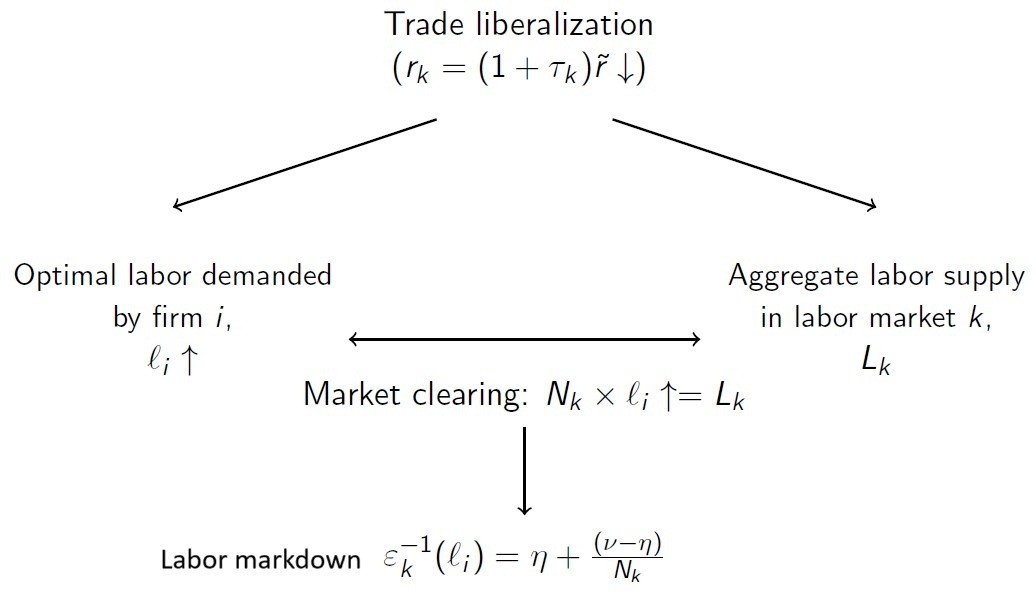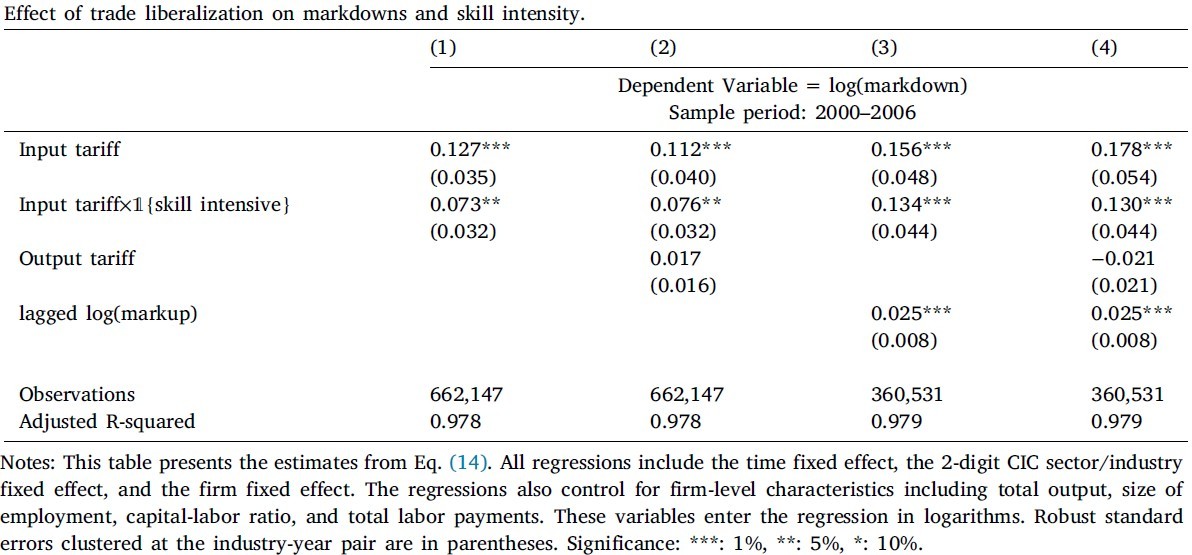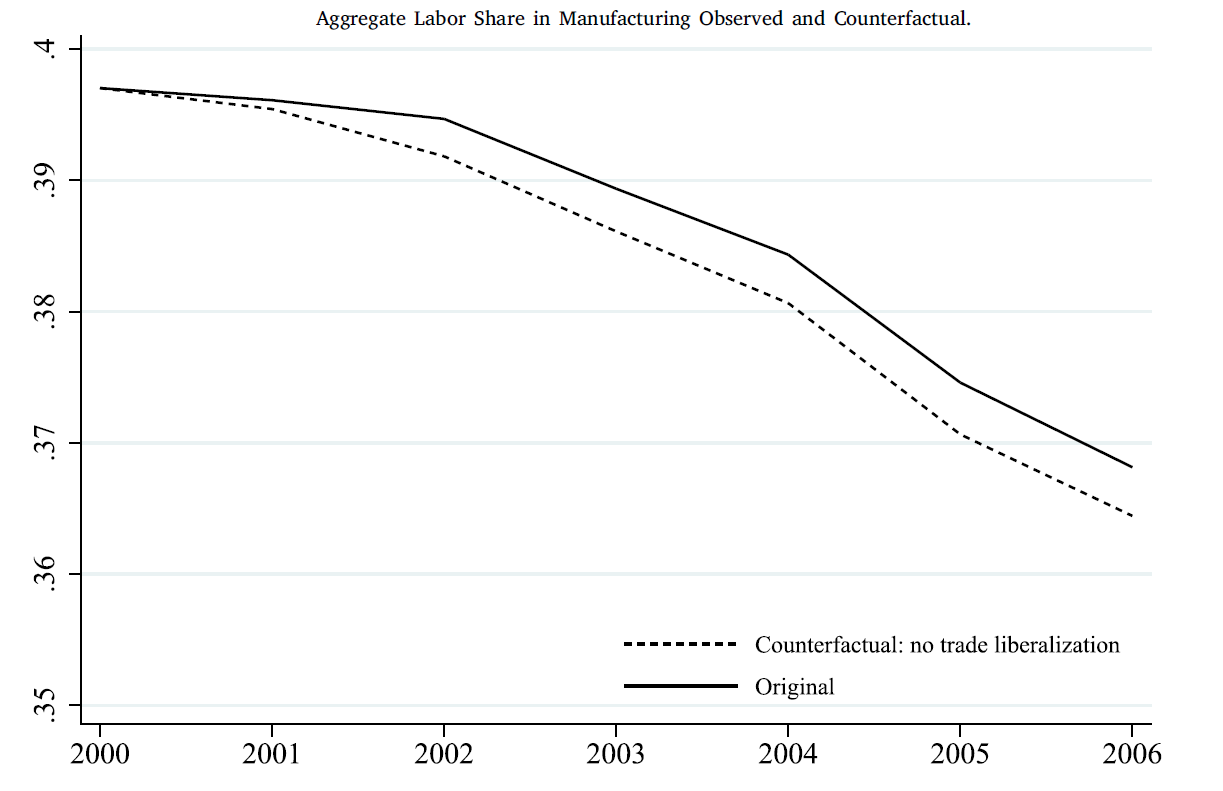Input Trade Liberalization and Firm Labor Market Power in China
More trade, more jobs? Or fewer? China’s accession to the WTO has catalyzed a rich research agenda on the labor market consequences of trade liberalization. Departing from the assumptions of perfectly competitive labor markets, we ask whether Chinese firms exercised more or less labor market power when input tariffs fell with China’s WTO accession? We show that input trade liberalization reduced labor monopsony power in China, especially for skill-intensive firms and in markets with more labor supply growth.

Introduction
Trade reforms have been shown to have important labor market effects. When tariffs fall, industries and locations more exposed to rising import competition can experience lower employment and lower wages relative to less exposed locations, and the effects can vary across occupations or by worker skill (Davidson and Matusz, 2004; Golberg and Pavcnik, 2007; Topalova, 2010; Autor et al., 2013; Dix-Carneiro et al., 2014; Ebenstein et al., 2014; Kondo, 2018;). Less is known, however, about the interaction between trade reforms and labor market imperfections.
China provides a particularly interesting case for studying the relationship between trade reform and labor monopsony power. Since its unprecedented trade liberalization in the early 2000s, China has become one of the world’s largest exporters and importers. At the same time, the flexibility of China’s labor market remains disputed, due in part to the well-known Hukou registration system, which restricts internal migration across regions. In China – the largest labor force in the world, twice as large as the combined labor forces of the U.S. and E.U. – labor’s income share is quite low, steadily declining from approximately 40 percent of value-added in manufacturing in 2001. Firms’ labor monopsony power is viewed as a potential explanation for the declining labor share of income observed in many countries (Karabarbounis and Neiman, 2014). These institutional constraints, along with China’s low labor share of income, suggest the potential presence of significant monopsony power in its labor market.
Markdowns and input tariffs: A simple model and evidence
In our recent paper (Kondo et al., 2024), we examine the effect of input trade liberalization on firms’ labor monopsony power in China, and how firms’ skill intensity shapes this effect. We first develop a stylized general equilibrium model to characterize the endogenous response of labor monopsony power to changes in input tariffs. The increase in labor demand unequivocally pushes up labor monopsony power only if the aggregate amount of labor supply remains unchanged. Figure 1 illustrates the intuition behind this prediction. In the model, a decline in input tariffs leads firms to demand more labor l. If the aggregate quantity of labor supplied Lk remains unchanged, higher labor demand would imply a reduction in the number of firms Nk at equilibrium, resulting in greater labor market power for the remaining firms. Alternatively, labor market power falls if the aggregate quantity of labor supply relocating to labor market k rises enough. Therefore, the model suggests that the response of labor monopsony power to trade reform is an equilibrium phenomenon that depends crucially on labor supply dynamics.
Figure 1

Note: rk denotes the price of intermediate inputs for firms operating in market k. Tariff is denoted by τ. Labor markdown depends on the inverse labor supply elasticity, which is denoted by ε-1.
Guided by our theoretical predictions, we use plant-level production data from the Annual Survey of Chinese Industrial Enterprises to estimate the impact of input trade liberalization on firms’ labor monopsony power. We estimate firm’s labor monopsony power, which we refer to as the labor markdowns, using the production method developed by Brooks et al. (2021) and Yeh et al., (2022). The labor markdown measures the wedge between the value of the marginal product of labor and the wage, beyond what is explained by a markup in the output market. We identify the effect of trade liberalization on labor monopsony power by leveraging the exogenous variation in tariff reductions following China’s accession to the WTO.
We find that input trade liberalization in China significantly reduces firms’ labor markdowns, and the effect is more pronounced for skill-intensive firms relative to non-skill-intensive firms (see table). This finding is robust to a number of markdown measures and alternative regression specifications.

Labor supply mechanism and aggregate implications
In addition, we present three pieces of evidence supporting the proposed aggregate labor supply mechanism. First, we show that labor markdowns fall more in labor markets where the aggregate labor expands during trade reform. Second, we show that labor markdowns in skill-intensive firms are influenced by the expansion of the skilled labor supply. Specifically, these firms experienced a greater reduction in markdowns in industries with a larger increase of the skilled labor supply. Third, firms with a large skilled labor market share also see their markdowns decrease more in regions undergoing significant contemporaneous college expansion reforms.
We infer the effect of input trade liberalization on labor monopsony power on the evolution of the aggregate labor share. Between 2000 and 2006, the labor share in China decreased by approximately 3 percentage points. Our estimates suggest that, in the absence of trade-driven markdown changes, the aggregate labor share would have decreased by about one-half percentage point more by the end of 2006 (see figure).

Conclusion
Recent studies have uncovered new evidence about the markdown response to trade reform. Unlike the case of China, Felix (2022) finds an increase in labor monopsony power following Brazil’s 1990-1994 trade reform. Compared to other works, our paper is unique in highlighting the role of aggregate labor supply in shaping the relationship between trade and labor monopsony power. Our analysis suggests that labor monopsony power may respond differently to trade reform across regions, driven by heterogenous labor supply dynamics. By emphasizing the role of aggregate labor supply, our paper offers a potential explanation that helps reconcile the seemly conflicting findings in the literature about the impact of trade liberalization on labor monopsony power.
Reference to the paper
Illenin O. Kondo, Yao Amber Li, Wei Qian, 2024, “Trade liberalization and labor monopsony: Evidence from Chinese firms.” Journal of International Economics 152, 104006
References
Autor, David H., Dorn, David, Hanson, Gordon H., 2013. “The China Syndrome: Local Labor Market Effects of Import Competition in the United States.” American Economic Review 103 (6), 2121–2168.
Brooks, Wyatt J., Kaboski, Joseph P., Li, Yao Amber, Qian, Wei, 2021. “Exploitation of labor? Classical monopsony power and labor’s share.” Journal of Development Economics 150, 102627.
Davidson, Carl, Matusz, Steven J., 2004. “International Trade and Labor Markets: Theory, Evidence, and Policy Implications.” W.E. Upjohn Institute for Employment Research, Kalamazoo, Michigan.
Dix-Carneiro, Rafael, 2014. “Trade liberalization and labor market dynamics.” Econometrica 82 (3), 825–885.
Ebenstein, Avraham, Harrison, Ann, McMillan, Margaret, Phillips, Shannon, 2014. “Estimating the impact of trade and offshoring on American workers using the current population surveys.” The Review of Economics and Statistics 96 (4), 581–595.
Felix, Mayara, 2022. “Trade, labor market concentration, and wages.” (Unpublished Manuscript).
Goldberg, Pinelopi, Koujianou, Pavcnik, Nina, 2007. “Distributional effects of globalization in developing countries.” Journal of Economic Literature 45 (1), 39–82.
Kondo, Illenin O., 2018. “Trade-induced displacements and local labor market adjustments in the US.” Journal of International Economics 114, 180–202.
Loukas Karabarbounis, Brent Neiman, 2014. “The Global Decline of the Labor Share.” The Quarterly Journal of Economics 129 (1), 61–103
Topalova, Petia, 2010. “Factor Immobility and Regional Impacts of Trade Liberalization: Evidence on Poverty from India.” American Economic Journal: Applied Economics 2 (4), 1–41.
Yeh, Chen, Claudia Macaluso, and Brad Hershbein. 2022. "Monopsony in the US Labor Market." American Economic Review 112 (7): 2099–2138.

Latest
Most Popular
- VoxChina Covid-19 Forum (Second Edition): China’s Post-Lockdown Economic Recovery VoxChina, Apr 18, 2020
- China’s Great Housing Boom Kaiji Chen, Yi Wen, Oct 11, 2017
- China’s Joint Venture Policy and the International Transfer of Technology Kun Jiang, Wolfgang Keller, Larry D. Qiu, William Ridley, Feb 06, 2019
- The Dark Side of the Chinese Fiscal Stimulus: Evidence from Local Government Debt Yi Huang, Marco Pagano, Ugo Panizza, Jun 28, 2017
- Wealth Redistribution in the Chinese Stock Market: the Role of Bubbles and Crashes Li An, Jiangze Bian, Dong Lou, Donghui Shi, Jul 01, 2020
- What Is Special about China’s Housing Boom? Edward L. Glaeser, Wei Huang, Yueran Ma, Andrei Shleifer, Jun 20, 2017
- Privatization and Productivity in China Yuyu Chen, Mitsuru Igami, Masayuki Sawada, Mo Xiao, Jan 31, 2018
- Evaluating Risk across Chinese Housing Markets Yongheng Deng, Joseph Gyourko, Jing Wu, Aug 02, 2017
- How did China Move Up the Global Value Chains? Hiau Looi Kee, Heiwai Tang, Aug 30, 2017
- China’s Shadow Banking Sector: Wealth Management Products and Issuing Banks Viral V. Acharya, Jun Qian, Zhishu Yang, Aug 09, 2017




 Facebook
Facebook  Twitter
Twitter  Instagram
Instagram WeChat
WeChat  Email
Email 


